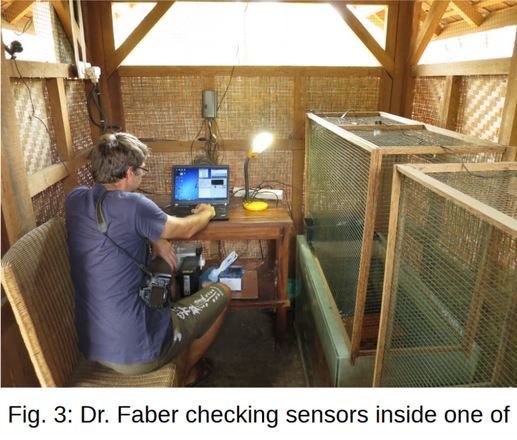Project Description
We carefully reviewed the anecdotal evidence of the existence of such precursors, as well as the options for scientific investigation, built three observation stations in Indonesia (Fig. 3), and conducted measurements there for three years. We found a few signal patterns derived from animal observation worth pursuing showing some similarity to measurements by other researchers (concerning e.g. disturbances of the ionosphere). Although earthquakes happen frequently in the overall target area, on a local scale (at our stations) we still don’t get a sufficient number to add up to a statistically significant population.
Geology:
 In order to get sufficiently many significant data, we should observe (not just discrete events we have to wait for, but) the on-going processes – mechanical and possibly electromagnetic – in geologically active zones, i.e. within approx. 10 miles around an active (seismogenic) fault. In this line of work, we want to verify the faults, understand the fault mechanism as best we can from observation, and find promising areas where geophysical and bioactivity sensor arrays can be maintained for long periods of time.
In order to get sufficiently many significant data, we should observe (not just discrete events we have to wait for, but) the on-going processes – mechanical and possibly electromagnetic – in geologically active zones, i.e. within approx. 10 miles around an active (seismogenic) fault. In this line of work, we want to verify the faults, understand the fault mechanism as best we can from observation, and find promising areas where geophysical and bioactivity sensor arrays can be maintained for long periods of time.
Geophysics:
 Continual observation of the processes at depth requires determination (incl. separation from noise) of very weak geophysical signals. This in turn requires sensor arrays (in contrast to single sensors), high-resolution digitizing, exact time-keeping, and superior signal filtering and processing (which we are still working on). We have acquired and tested sensors for seismic, acoustic, electric, magnetic, and atmospheric quantities, and are about to build a suitable data collection and transmission unit.
Continual observation of the processes at depth requires determination (incl. separation from noise) of very weak geophysical signals. This in turn requires sensor arrays (in contrast to single sensors), high-resolution digitizing, exact time-keeping, and superior signal filtering and processing (which we are still working on). We have acquired and tested sensors for seismic, acoustic, electric, magnetic, and atmospheric quantities, and are about to build a suitable data collection and transmission unit.
Biophysics:
 The Indonesian partners have operated various activity sensors, suitable for use on small and medium-sized animals, as well as cameras, and built custom data collection and transmission units. The biological constraint turned out to be the use of animals (rat, catfish, chicken, cattle, buffalo), the keeping and behavior of which is known to local people, and also sufficiently well in a scientific sense, to be analyzed against the data. Challenges are the long-term reliability of data gathering units in remote places and extraction of valid animal activity patterns.
The Indonesian partners have operated various activity sensors, suitable for use on small and medium-sized animals, as well as cameras, and built custom data collection and transmission units. The biological constraint turned out to be the use of animals (rat, catfish, chicken, cattle, buffalo), the keeping and behavior of which is known to local people, and also sufficiently well in a scientific sense, to be analyzed against the data. Challenges are the long-term reliability of data gathering units in remote places and extraction of valid animal activity patterns.Project Members:
Dr.rer.nat. Wolfgang Straka
Institute of Applied Geology, University of Natural Resources and Life Sciences, Austria
wolfgang.straka@boku.ac.at
Dr. Robert Faber
TerraMath Geoscientific Software, Buleleng, Bali, Indonesia
robert.faber@terramath.com
Project Details
- Date März 23, 2016
- Tags Physics

Comments are closed.